Class 8 History Chapter 8 Notes - The Making of the National Movement: 1870s
| Table of contents |

|
| The Emergence of Nationalism |

|
| A Nation in the Making |

|
| The Growth of Mass Nationalism |

|
| The March to Dandi |

|
| Quit India and Later |

|
| Important Dates |

|
The Emergence of Nationalism
- In the mid-1800s, people in India recognised that the country belonged to all its citizens, regardless of class, colour, caste, creed, language, or gender.
- This awareness was articulated by political groups that formed post-1850, particularly in the 1870s and 1880s.
- Many of these organisations were led by educated professionals, especially lawyers.
- Significant associations included the Poona Sarvajanik Sabha, the Indian Association, the Madras Mahajan Sabha, and the Bombay Presidency Association.
- A key realisation was that India belonged to all its people. There was also an understanding that the British were controlling the resources and lives of Indians.
- Until this control was removed, India could not truly belong to its own citizens.
(a) Role of Political Associations
- After 1850, political associations, particularly those formed in the 1870s and 1880s, led by English-educated professionals, began articulating this consciousness.
- Notable organizations, like the Poona Sarvajanik Sabha, Indian Association, Madras Mahajan Sabha, Bombay Presidency Association, and the Indian National Congress, aimed at national unity with goals transcending regional, communal, or class boundaries.
Note: The name "Poona Sarvajanik Sabha" translates to "of or for all the people," with "sarvajanik" derived from the words "sarva," meaning "all," and "janik," meaning "of the people."
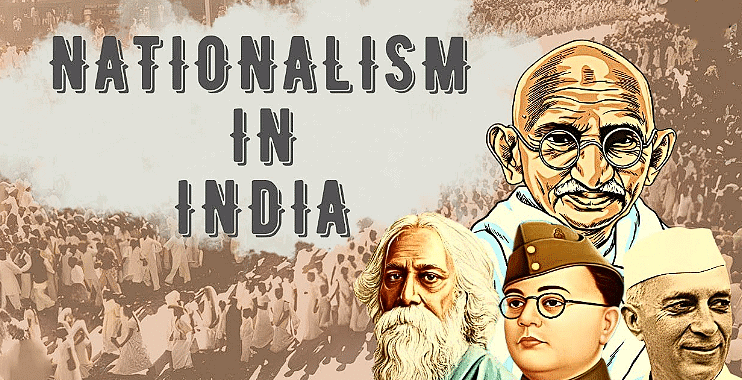 Nationalism in India
Nationalism in India
(b) Sovereignty and Empowerment
Sovereign means having the ability to act independently without any outside interference.
- These associations advocated for the sovereignty of the people.
- They emphasized that Indians should have the power to make decisions about their affairs.
- The idea was that the resources and systems of the country were meant for the collective well-being of all citizens.
(c) Intensifying Dissatisfaction with British Rule
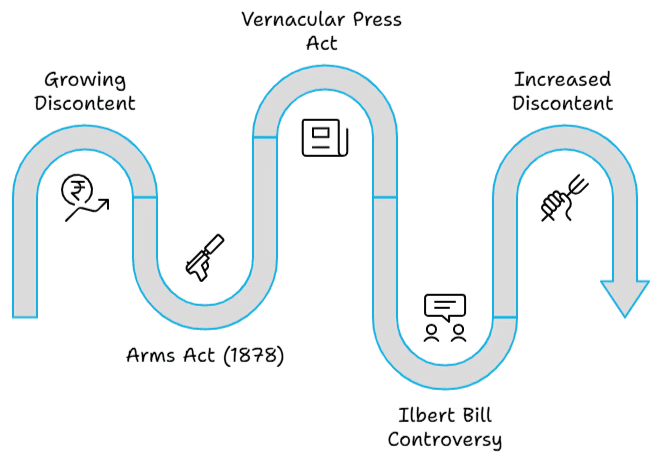
- In the 1870s and 1880s, discontent with British rule grew.
- Legislation such as the Arms Act (1878) and the Vernacular Press Act aimed at suppressing dissent.
- The Vernacular Press Act empowered the government to seize the assets of newspapers, including their printing presses, if published content was found to be "objectionable."
- The 1883 controversy over the Ilbert Bill promoted equality in trials, highlighting the racial attitudes of Britishers toward Indians.
- This controversy fueled discontent further.
(d) Formation of the Indian National Congress
- The need for an all-India organization intensified after the Ilbert Bill controversy.
- In December 1885, the Indian National Congress was established in Bombay with 72 delegates from across the country.
- Early leaders, including Dadabhai Naoroji, Pherozeshah Mehta, Badruddin Tyabji, W.C. Bonnerji, Surendranath Banerji, Romesh Chandra Dutt, and S. Subramania Iyer, played pivotal roles. Dadabhai Naoroji, a London-based businessman and publicist, and A.O. Hume, a retired British official, guided the emerging nationalist movement by uniting Indians from diverse regions.
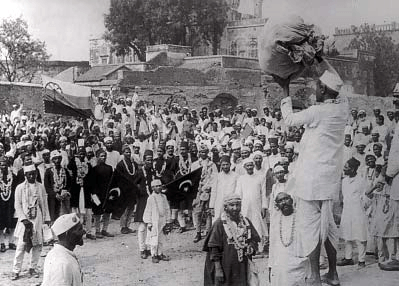 Boycott movement
Boycott movement
A Nation in the Making
It has often been said that the Congress in the first twenty years was moderate in its goals and methods. During this time, it sought a bigger role for Indians in government and administration. It wanted the Legislative Councils to be more representative, to have more power, and to be established in provinces where they did not exist. It called for Indians to hold high positions in government and for civil service examinations to take place in India as well, not just in London. This push for the Indianisation of administration was part of a campaign against racism, as most important jobs were held by white officials.
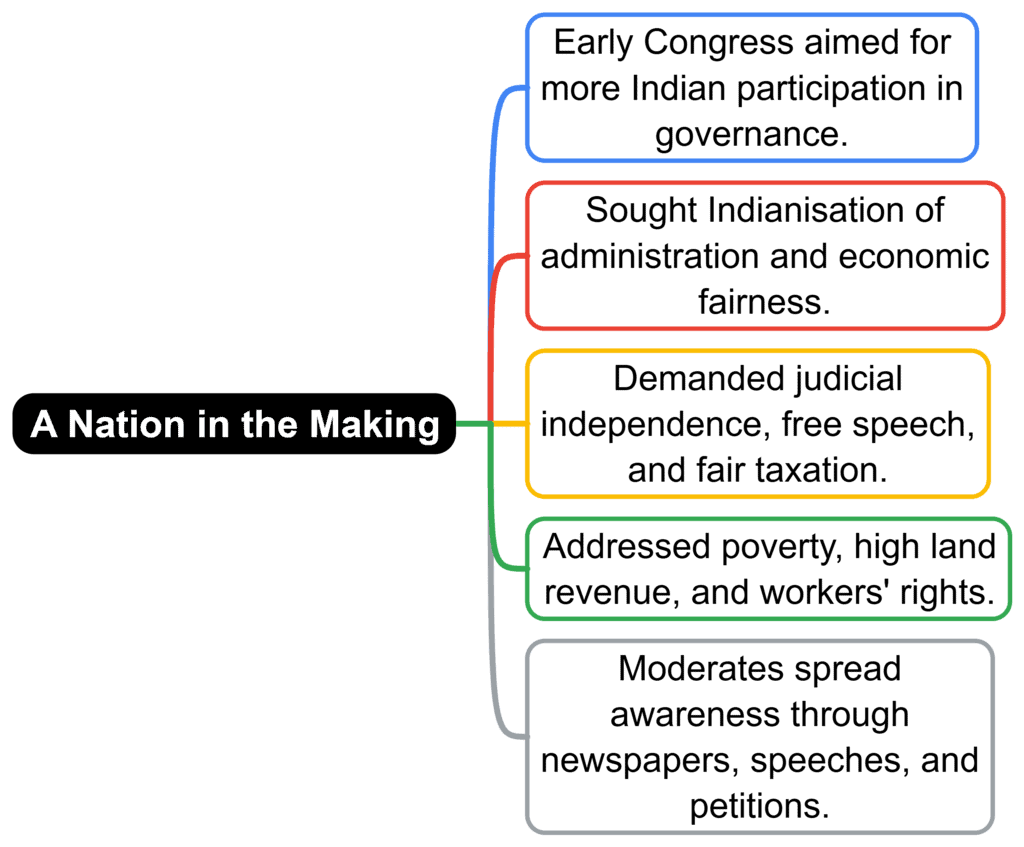
(a) Making the Government More Indian: Fighting Against Racism
- The Congress also wanted more Indians in important roles because back then, most of these important roles were given to white officials.
- The British thought Indians couldn't handle important responsibilities. The Congress hoped that if more Indians were in charge, less money would be sent to England by British officers, helping India keep more of its wealth.
- They also asked for other things like separating the judiciary from the executive, getting rid of the Arms Act, and freedom of speech.
(b) Economic Issues and National Representation: Early Congress Concerns
- The Congress didn't just speak for rich or educated people. They talked about problems like poverty and famines caused by British rule.
- They wanted less land revenue, fewer military expenses, and more money for irrigation.
- They also discussed things like the salt tax, the treatment of Indian workers abroad, and the difficulties faced by people living in forests because of strict forest rules.
(c) Moderate Leaders' Plan: Spreading the Word
- The leaders of the Congress who were called "Moderates" had a plan. They wanted to raise awareness in the public about how the British rule was not fair.
- They wrote in newspapers, gave speeches, and sent representatives to different parts of the country to tell people about the issues.
- They thought that if they told the British government what Indians wanted, the British, who valued freedom and justice, would listen.
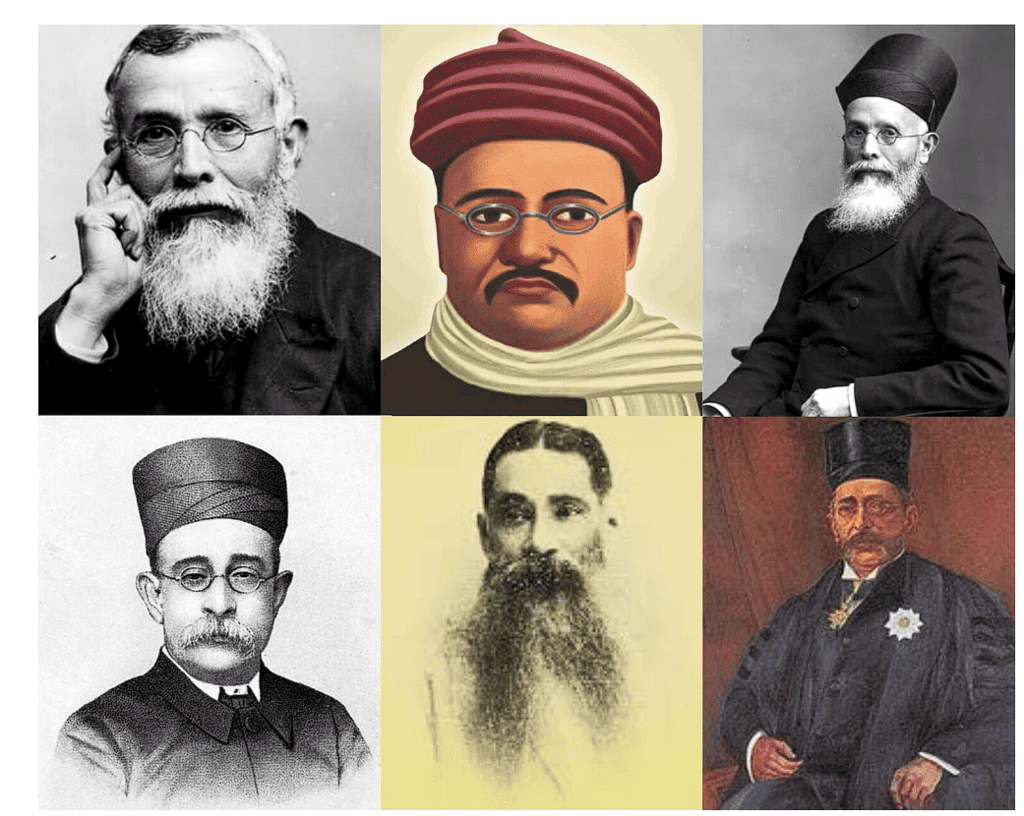 The Moderate Phase of Indian Nationalism
The Moderate Phase of Indian Nationalism
Freedom is our Birthright
In Bengal, Maharashtra and Punjab, leaders such as Bipin Chandra Pal, Bal Gangadhar Tilak and Lala Lajpat Rai, popularly known as ‘Lal, Bal, Pal’, strongly criticized the policies of the colonial government.
 Lal, Bal, Pal
Lal, Bal, Pal
- By the 1890s, Indian leaders like Bepin Chandra Pal, Bal Gangadhar Tilak, and Lala Lajpat Rai began advocating for more radical objectives and methods, criticizing the Moderates for their passive approach and emphasizing self-reliance.
- Tilak famously declared, "Freedom is my birthright and I shall have it!"
- In 1905, Viceroy Curzon partitioned Bengal, a move that sparked widespread outrage across India, leading to the Swadeshi movement that opposed British rule and promoted self-help, national education, and the use of Indian languages.
- The partition of Bengal by the British, caused a lot of anger. The Congress, both the polite ones and the more radical ones, opposed this move.
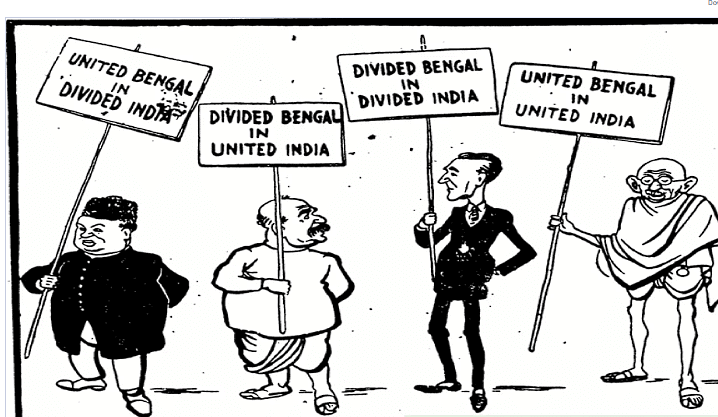 Bengal Partition
Bengal Partition
- This opposition turned into the Swadeshi movement, where people avoided using British goods and started doing things on their own.
- The Swadeshi movement involved mass mobilization, boycotts of British goods and institutions, and some individuals even suggested the need for "revolutionary violence" to overthrow British rule.
- In 1906, the All India Muslim League was formed, supporting the partition of Bengal and advocating for separate electorates for Muslims, a demand that was granted by the government in 1909. Some seats in the councils were now reserved for Muslims, and these seats would be filled by Muslim voters through a separate election process.
- The Congress split in 1907 over the use of boycott as a means of protest, with the Moderates opposing it. The split was eventually resolved, leading to the signing of the Lucknow Pact in 1916 between the Congress and the Muslim League, aiming to work together for representative government in India.
The Growth of Mass Nationalism
Mass Movement Against British Rule After 1919
- After 1919, the struggle against British rule in India evolved into a mass movement, involving peasants, tribals, students, women, and occasionally factory workers. Certain business groups also began to support the Congress Party during this period.
- The First World War had a significant impact on India, leading to increased defense expenditure by the government. The government raised taxes on individual incomes and business profits to fund this.
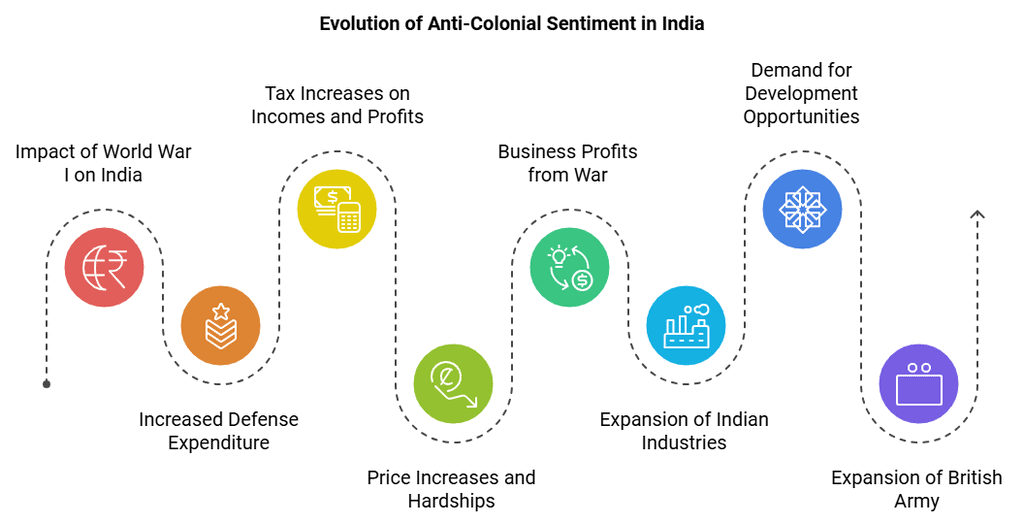
- The rise in military spending and the demand for war supplies caused a sharp increase in prices, creating hardships for the common people.
- In contrast, business groups made substantial profits from the war due to increased demand for industrial goods like jute bags, cloth, and rails, along with a decline in imports.
- As a result, Indian industries expanded during the war, and business groups began to demand greater development opportunities.
- The war also led the British to expand their army, with villages pressured to supply soldiers for foreign conflicts. Many soldiers who returned after the war became aware of the exploitation by imperialist powers in Asia and Africa. These events led to a desire to oppose colonial rule in India.
- Additionally, the 1917 Russian Revolution and the circulation of news about peasant and worker struggles, along with socialist ideas, inspired Indian nationalists to strengthen their resolve against British rule.
- In 1919, Gandhiji called for a satyagraha against the Rowlatt Act, which the British had recently enacted. This Act limited fundamental rights like freedom of expression and enhanced police powers. Mahatma Gandhi and others believed that the government had no right to restrict people's basic freedoms.
(a) The Advent of Mahatma Gandhi
- Mahatma Gandhi was born on 2nd October 1869 at Porbandar in Gujarat.
- He studied law in England and went to South Africa to practice law and stayed there for 20 years.

- In South Africa, Gandhiji struggle for the Indians in non-violent marches against racist restrictions and had earned great respect and popularity both at the national and international level.
- Mahatma Gandhi spent his initial years in India traveling throughout the country, understanding the people, their needs, and the overall situation.
- Gandhiji's involvement included local movements in Champaran, Kheda, and Ahmedabad, where he met Rajendra Prasad and Vallabhbhai Patel. In Ahmedabad, he led a successful strike by millworkers in 1918.
(b) The Rowlatt Satyagraha
In 1919, Gandhiji called for a satyagraha against the Rowlatt Act, which the British had just enacted. This Act restricted fundamental rights like freedom of expression and increased police powers.
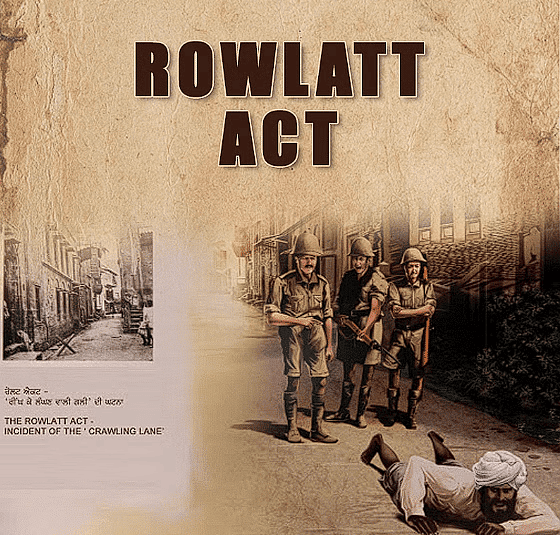
- Gandhiji, along with leaders like Mohammad Ali Jinnah, believed that the government had no right to limit people’s basic freedoms. They criticized the Act as "devilish" and tyrannical.
- Gandhiji urged the Indian people to observe April 6, 1919, as a day of non-violent opposition to the Act, marking it with humiliation, prayer, and hartal(strike).
- Satyagraha Sabhas were established to initiate the movement.
- The Rowlatt Satyagraha became the first all-India struggle against the British government, although it was mainly confined to cities.
- In April 1919, there were numerous demonstrations and hartals across the country, which the government tried to suppress with brutal measures.
- The Jallianwala Bagh massacre, carried out by General Dyer in Amritsar on Baisakhi day (April 13), was part of this repression.
- Upon learning about the massacre, Rabindranath Tagore expressed the nation’s pain and anger by renouncing his knighthood.
- During the Rowlatt Satyagraha, participants aimed to ensure that Hindus and Muslims were united in the struggle against British rule. This was also Gandhiji’s vision of India as a land for all its people, regardless of their religion.
- Gandhiji emphasized the importance of Hindus and Muslims supporting each other in any just cause.
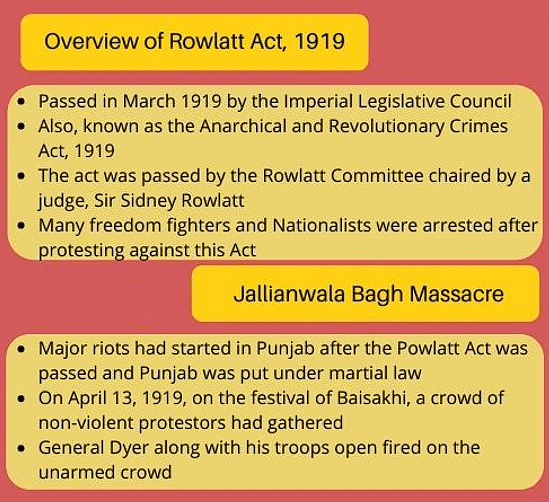
(c) Khilafat Agitation and the Non-Cooperation Movement
1920 Treaty and Indian Response
- In 1920, the British imposed a strict treaty on the Turkish Sultan, or Khalifa, which caused outrage in India, similar to the anger after the Jallianwala massacre.
- Indian Muslims were especially concerned about the Khalifa's control over Muslim holy sites in the former Ottoman Empire.
Khilafat Movement and Non-Cooperation Movement
- Leaders of the Khilafat movement, Mohammad Ali and Shaukat Ali, called for a broad Non-Cooperation Movement.
- Gandhi supported their call, urging the Congress to address the "Punjab wrongs" (related to the Jallianwala massacre), the Khilafat issue, and to demand swaraj (self-rule).
Non-Cooperation Movement Activities
- The Non-Cooperation Movement gained momentum between 1921 and 1922.
- Thousands of students left government schools and colleges.
- During 1921-22, Many lawyers, including Motilal Nehru, C.R. Das, C. Rajagopalachari, and Asaf Ali, stopped their practices.
- British honors were rejected, and legislatures were boycotted.
- People burned foreign cloth in public bonfires, leading to a significant drop in foreign cloth imports between 1920 and 1922.
Nationwide Upheaval
- This was just the beginning, as large parts of the country were on the brink of a major revolt.
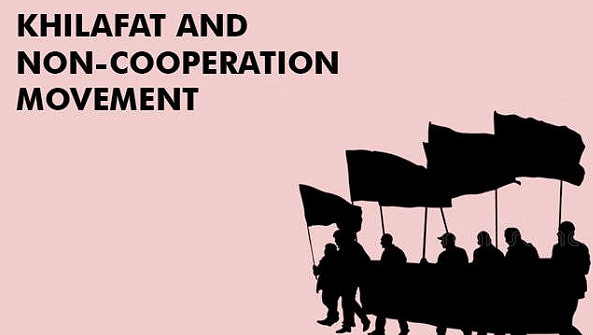
 Gandhi and Ahimsa (non-violence)
Gandhi and Ahimsa (non-violence)
(d) People’s Initiatives
Peasants organized non-violent campaigns against the high revenue demand of the British. 
- Kheda, Gujarat: Original: Patidar peasants in Kheda, Gujarat, protested peacefully against the British's high revenue demands.
Farmers in Kheda, Gujarat, peacefully protested against the British government's high taxes. - Coastal Andhra and Interior Tamil Nadu: Original: People in Coastal Andhra and Tamil Nadu protested by blocking liquor shops.
In Coastal Andhra and Tamil Nadu, citizens protested by preventing the sale of alcohol. - Bengal: Original The Khilafat-Non-Cooperation alliance in Bengal strengthened communal unity in the national movement.
The Khilafat-Non-Cooperation alliance in Bengal strengthened communal unity in the national movement. In Bengal, an alliance called Khilafat-Non-Cooperation brought different communities together in the national struggle. - Punjab: The Akali agitation in Punjab aimed to remove corrupt mahants (religious leaders) from gurudwaras, with British support. In other words, the Akali movement tried to oust corrupt religious leaders from gurudwaras, who were backed by the British.
(e) The People’s Mahatma
- People looked up to Gandhiji as a leader who could rescue them from their tough lives and poverty.
- Gandhiji wanted to bring people together, not make them fight.
- Sometimes, ordinary people attributed their own successes to Gandhiji. For example, after a strong movement, peasants in Pratapgarh (now Uttar Pradesh) stopped illegal tenant evictions, believing Gandhiji had achieved this for them.

(f) The Happenings of 1922-29
Gandhiji's Stance on Violence: Mahatma Gandhi was strongly against violent movements. He believed in non-violence as a principle of protest.
Chauri Chaura Incident (1922): In February 1922, during a protest in Chauri Chaura, a group of peasants set a police station on fire, leading to the death of 22 policemen. The peasants were angered because the police had fired on their peaceful protest.
Calling off the Non-Cooperation Movement: Gandhiji was deeply disturbed by the violence and decided to call off the Non-Cooperation Movement after the Chauri Chaura incident.
New Focus for the Congress: After the movement ended, Gandhiji’s followers suggested that the Congress should focus on constructive work in rural areas, such as social upliftment and education.
Debate on Participation in Elections: Leaders like Chitta Ranjan Das and Motilal Nehru believed that the Congress should participate in elections to the councils. They thought this would allow them to influence government decisions from within.
Building a Support Base: During the mid-1920s, Gandhian supporters engaged in social work in villages. This helped them increase their support among the masses, which became useful when the Civil Disobedience Movement was launched in 1930.
Formation of New Political Groups: Two significant political groups were formed in the mid-1920s:
- The Rashtriya Swayamsevak Sangh (RSS), a Hindu nationalist organization.
- The Communist Party of India, which had very different ideas about India's future compared to the RSS.
Bhagat Singh’s Revolutionary Activities: During this period, revolutionary nationalist Bhagat Singh was also active, promoting ideas of independence through direct action and revolution.
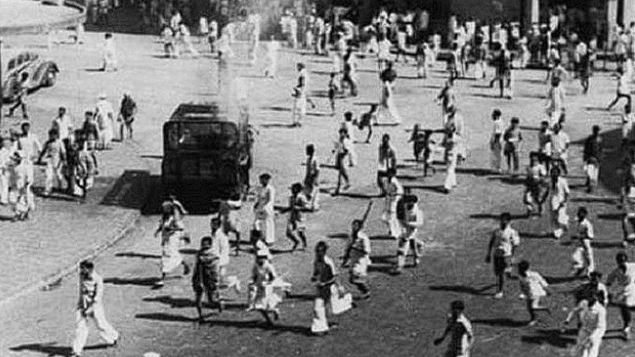 Chauri- Chaura Incident
Chauri- Chaura Incident
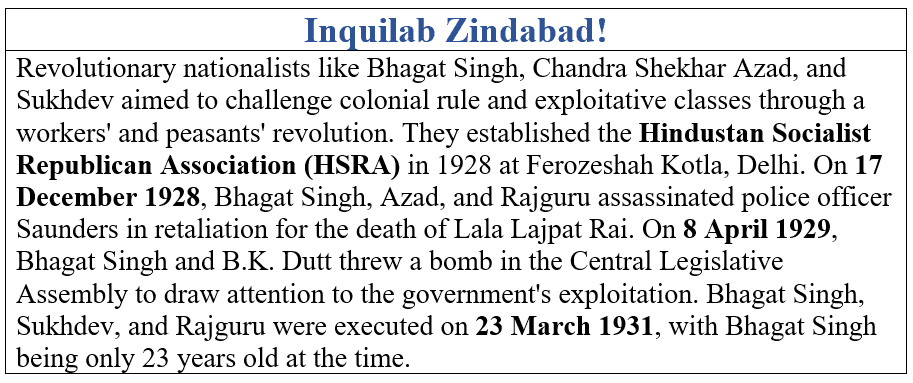
The March to Dandi
In 1930, Gandhiji started the march to break the Salt Law. According to this law, the state had a monopoly on the manufacture and sale of salt.
 Dandi March
Dandi March
- Gandhiji and his followers marched from Sabarmati Ashram to the coastal town of Dandi where they broke the Salt law by gathering natural salt found on the seashore are boiling seawater to produce salt.
- The government attempted to suppress the movement with brutal actions against peaceful satyagrahis, resulting in the imprisonment of thousands.
- The combined struggles of the Indian people bore fruit when the Government of India Act of 1935 prescribed provincial autonomy and the government announced an election to the provincial legislature in 1937.
- The Second World War broke out in September 1939. The Congress leaders were ready to support the British war effort. But in return, they wanted India to be granted Independence after the war. The British refused to concede the demand and the Congress ministers resigned in protest.

Quit India and Later
- Mahatma Gandhi started a new protest against the British during World War II called the Quit India Movement.
- Gandhiji and other leaders were promptly jailed, but the movement continued to spread, particularly attracting peasants and youth who abandoned their studies to join it.
- In response, the British government reacted harshly by arresting over 90,000 people and causing about 1,000 deaths in clashes with the police by the end of 1943. This was a period of intense repression.
Towards Independence and Partition
- In 1940, the Muslim League proposed the creation of "Independent States" for Muslims without specifically mentioning partition or Pakistan.
- The League started to view Muslims as a separate "nation" from Hindus in the late 1930s, possibly influenced by historical tensions between Hindu and Muslim groups in the 1920s and 1930s.
- The provincial elections of 1937 convinced the League that Muslims were a minority and would always be in a subordinate position in any democratic structure, leading to their call for an autonomous arrangement.
- The League aimed to expand its social support in the early 1940s, especially when Congress leaders were imprisoned, and the failure of the Congress to mobilize Muslim masses in the 1930s allowed the League to gain more support.
- Negotiations for India's independence in 1945 failed as the League insisted on being the sole representative of India's Muslims, a claim the Congress could not accept due to significant Muslim support for the Congress.
- Elections in 1946 showed the League's success in Muslim-reserved seats, leading to its continued demand for Pakistan. The British Cabinet's mission suggested a loose confederation for a united India with autonomy for Muslim-majority areas, but agreement could not be reached, making partition almost inevitable.
- After the failure of the Cabinet Mission, the Muslim League resorted to mass agitation for Pakistan, culminating in "Direct Action Day" on August 16, 1946, marked by riots in Calcutta and subsequent violence across northern India.
- The violence escalated by March 1947, resulting in the deaths of hundreds of thousands, brutalities against women, and millions becoming refugees due to the Partition, leading to the birth of Pakistan as a new country.
- The independence from British rule brought a mix of joy and pain, with the violence and trauma of Partition altering India's landscape and cities significantly.
Important Dates
- 1885: All India Congress was set up
- 1905: Lord Curzon partitioned Bengal
- 1906: The Muslim League was established in Dhaka
- 1907: The Indian National Congress was divided in extremists and moderates
- 19 15 December: the extremists and the moderates United again in the Lucknow session
- 1917: the Russian Revolution.
- 1915: Gandhiji arrived in India
- 1918: Ahmedabad mill Strike
- 1919: Rawlatt Satyagraha
- 6th April 1919: Gandhiji act the Indian people to observe the day as a day of non-violent opposition to the Rowlatt Act
- 13th April 1919:JallianwalaBagh massacre
- 1920: the British imposed A harsh Treaty on the Turkish Sultan of Khalifa
- 1922 February: chaurichaura incident
- 1929: The PurnaSwaraj Resolution was passed
- 26 January 1930: the day was observed as the first independence day
- 1928: The Hindustan Socialist Republican Association was formed by Bhagat Singh
- 17th December 1928: Bhagat Singh Sukhdev, Rajguru assassinated Saunders.
- 8 April 1929: Bhagat Singh and Batukeshwar Dutt bomb in the central Legislative Assembly.
- 23rd March 1931: Bhagat Singh, Sukhdev, Rajguru were hanged
- 1930: Dandi March of Gandhiji
- 1937: the provincial elections
- 1939 to 1945: Second World War
- March 1946: the British cabinet sent a three-member mission to Delhi to examine this demand and to suggest a suitable political Framework for every Indian
- 16th August 1946: Muslim League observed this day as a direct action day
|
69 videos|556 docs|46 tests
|
FAQs on Class 8 History Chapter 8 Notes - The Making of the National Movement: 1870s
| 1. What were the main factors that contributed to the emergence of nationalism in India during the 1870s? |  |
| 2. What was the significance of the March to Dandi in the context of Indian nationalism? |  |
| 3. How did the Quit India Movement contribute to the growth of mass nationalism in India? |  |
| 4. What role did cultural and educational reforms play in the making of the national movement? |  |
| 5. What were some important dates and events associated with the national movement in the late 19th and early 20th centuries? |  |















